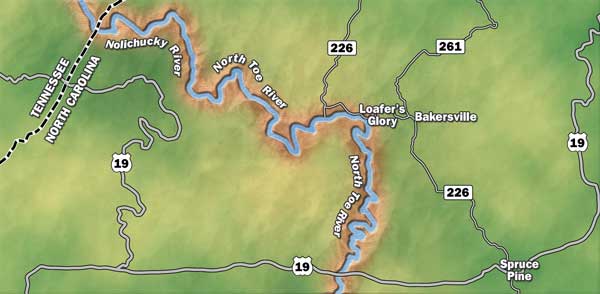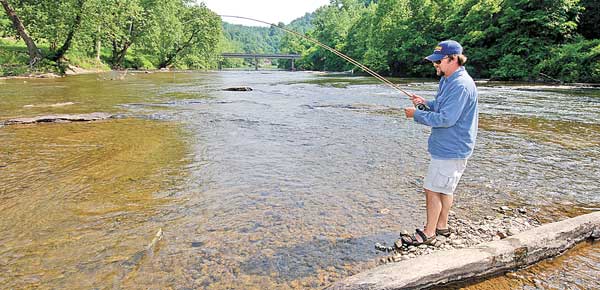
The North Toe and Nolichucky rivers are filled with a mixed bag for fly-fishermen, including feisty bronzebacks.
Scott Cunningham backed his trailer down a steep incline, the sort of grade where an angler hopes his parking brake holds when he off-loads his boat, lest he need a wrecker or winch to fish his pickup out of the water.
Cunningham and another fishing guide, Jesse Buchanan, wrestled an inflatable raft off the trailer and slid it into the whispering water.
Cunningham’s passengers climbed aboard the 13-foot Aire Super Puma. And after he sloshed the sand and silt from his sandals, he hopped in. Before the first smallmouth bass cover came into view, he had his anglers stretch their fly lines so he could gauge their fishing and casting abilities.
“Some people are really great fly casters, and others are great fishermen,” he said. “But it’s hard to find one angler who has both skills.”
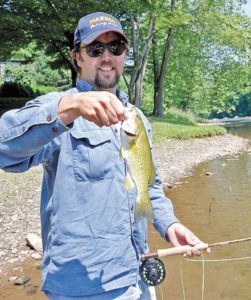
When the first couple of casts he saw appeared favorable, Cunningham oared the boat down one bank. He pointed out rock formations below the surface where steep ledges downstream would likely hold fish.
Multiple species lure anglers to this river system
“We catch smallmouth bass, sunfish and rock bass mostly,” he said, “but it’s the smallmouth that brings the most fishermen to the North Toe River and the Nolichucky River. It’s some of the most beautiful scenery in the world. And there are lots of fish to catch. It also has some stretches of water that are relatively easy to fish.”
A popping bug cast upstream of the ledge Cunningham had pointed out resulted in a strike from a smallmouth that weighed about a pound. That’s a typical fish for the river system. But Cunningham said 5-pounders are always a possibility. Catch one that size on fly tackle, and the Toe River system will hook you for life.
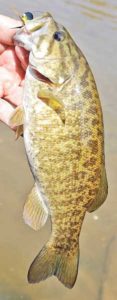
“It’s not whitewater, so the thrill-seekers aren’t here,” Cunningham said. “For a river at a higher elevation, the North Toe may be the tamest river in the state. You might find a trout in here somewhere. The water is too warm for trout, so it’s not a river for fly-fishing purists. But if you really want to bug a bass, the North Toe River can’t be beat.”
Look for good water levels to fish
The headwaters of the North Toe are around Newland, and it flows westward, forming the boundary between Avery and Mitchell counties. The South Toe, which has its headwaters on the east slope of Mount Mitchell in Yancey Co., joins up around Micaville to form the Toe River. It then becomes the Nolichucky at its confluence with the Cane River north of Burnsville. Outstanding scenery can be found throughout the Toe River system, and good fishing can also be found in most areas.
“You want to fish the river when the water level is not too high and not too low,” Cunningham said. “Using inflatable kayaks and wade fishing are very popular methods. But I seldom let my clients get out of the boat where the bottom is rocky. The rocks are slippery, and you can fall or twist your ankle.”
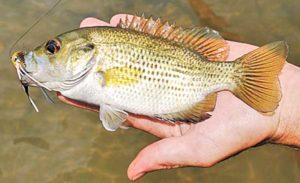
Presentation is more important than casting distance
A cast beneath an overhanging branch resulted in another strike from a smallmouth that made a jumping, twisting, flopping trip to the boat.
Cunningham said presentation is the key to catching lots of fish — as soon as a fisherman learns how to spot the cover that holds fish.
“You want to lay the popping bug in a pocket downstream from cover,” he said. “In calm water, drop the bug close to the banks or any woody structure. Bass love wood.”
While trout fishermen want gentle presentations, Cunningham wants the bug to smack down against the water. After the splashy presentation gets some initial attention from fish, he lets the bug sit until the concentric circles have died out. Then he pops it one time, perhaps twice, before making another cast.
Let the fly do the work
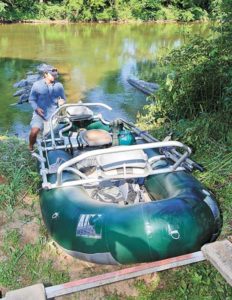
“Most anglers are too impatient,” he said. “You have to let the bug do its work. The feathers and rubber legs are moving in the current, so you don’t have to do much of anything.”
Besides keeping a good upstream bend in the line so the current doesn’t drag the bug and line downstream, the most important thing is to let the bug sit, he said. If a few casts to a good spot don’t result in a strike, move on.
“The idea is to make a good cast to as many different spots as you can during a drift,” he said. “You don’t want to spend too much time on any spot so you can make your take-out on time. We put in near Roses Branch Rd. and will be taking out at Loafer’s Glory. That’s an easy day’s fishing if you move along at a good pace, casting from place to place. You can also put in at Loafer’s Glory and fish the stretch downstream.”
Pay attention to the sky
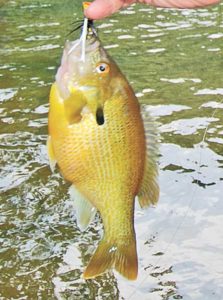
Cloud cover accompanied by a light wind darkened the water and made a slight ripple. The fish stopped striking, so Cunningham removed the bug and tied on a larger one.
“When visibility declines because of time of day or an overcast sky, I always tie on a bigger, darker popping bug,” he said. “It gives a better silhouette for fish to see.”
Another trick is switching to darker colors.
Some of the best pieces of cover turned out to be small caves in the rocks. Deep, yawning holes begged for popping bugs. Beautiful green sunfish in their spawning colors showed off their bright yellow fins after being hooked and hauled from the caves. Other catches included redbreast sunfish, which were mostly pale yellow with brassy bellies and the characteristic electric-blue lightning bolts near their mouths. Rock bass or “redeyes” made up some other catches.
Several casts resulted in snagged flies that couldn’t be retrieved. Some were destroyed by rocks or battered by fish.
“You have to bring lots of popping bugs,” Cunningham said. “I go through 30 dozen popping bugs a season, but that’s not bad if you compare it to the number of fish you’re going to catch. In a typical day, you’ll catch several dozen fish of all kinds. A good day is a dozen or two smallmouth bass and lots of sunfish as a bonus.”
Buchanan, who met Cunningham at Loafer’s Glory to help with the take-out, also fishes the river system.
 Extra adventure can be found farther downstream
Extra adventure can be found farther downstream
“My favorite river is the Nolichucky,” he said. “It’s gets rougher farther downstream, but the upper Nolichucky is fairly easy fishing. I put in at Huntdale and take out at the U.S. Forest Service ramp at Poplar, and that gives a good day’s fishing.”
While experts like Buchanan can catch fish downstream of Poplar, he said it’s rough going from there to the Tennessee state line.
“There’s some good fishing in the whitewater,” he said, “but it’s not the type of fishing that’s safe for amateurs. It’s a lot different. You have to use a drift boat, and there’s not much wading. The gradient is steep, and the water is fast, with boulders sticking up everywhere. For whitewater experts, fishing that stretch is exhilarating. There are some big smallmouth bass. But they’re really hard to get at because of the conditions. For most fishermen, it’s better, safer, and more productive to stick to the quieter stretches upstream of Poplar.”
Muskellunge are also an option nearby
Buchanan said he fishes from a boat in places where he has permission to launch from private ramps or along the highway right of ways that run alongside the river between Loafer’s Glory and Huntdale. But when launching a rigid-hulled boat, the area that can be fished is very constricted. Therefore, he also fishes from the bank or wades in different locations.
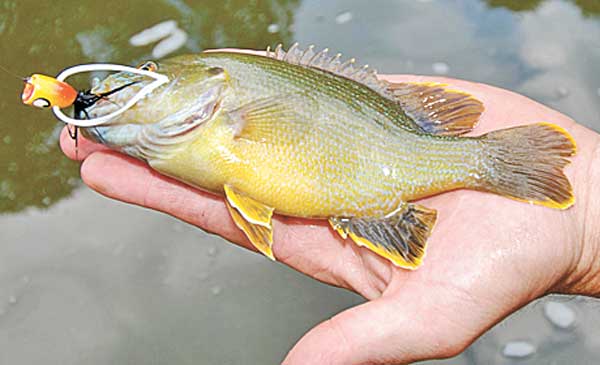
Buchanan prefers guide trips with fishermen who want to target muskellunge in the French Broad River or in Lake James. But he also guides many clients who are after smaller fare, including smallmouth bass. For personal pleasure, he fishes the Toe River system because he grew up there, taking advantage of its many treasures.
“There are so many places to fish along the North Toe and Nolichucky rivers that you can spend your life trying, and you won’t ever make a cast to them all,” he said. “It’s some of the best smallmouth fishing in the state, based on the numbers and sizes of fish. There’s always the possibility of catching a big smallmouth. But it’s the beauty of the river that will bring you back time after time. Once you’ve seen it, you can’t stay away.”

